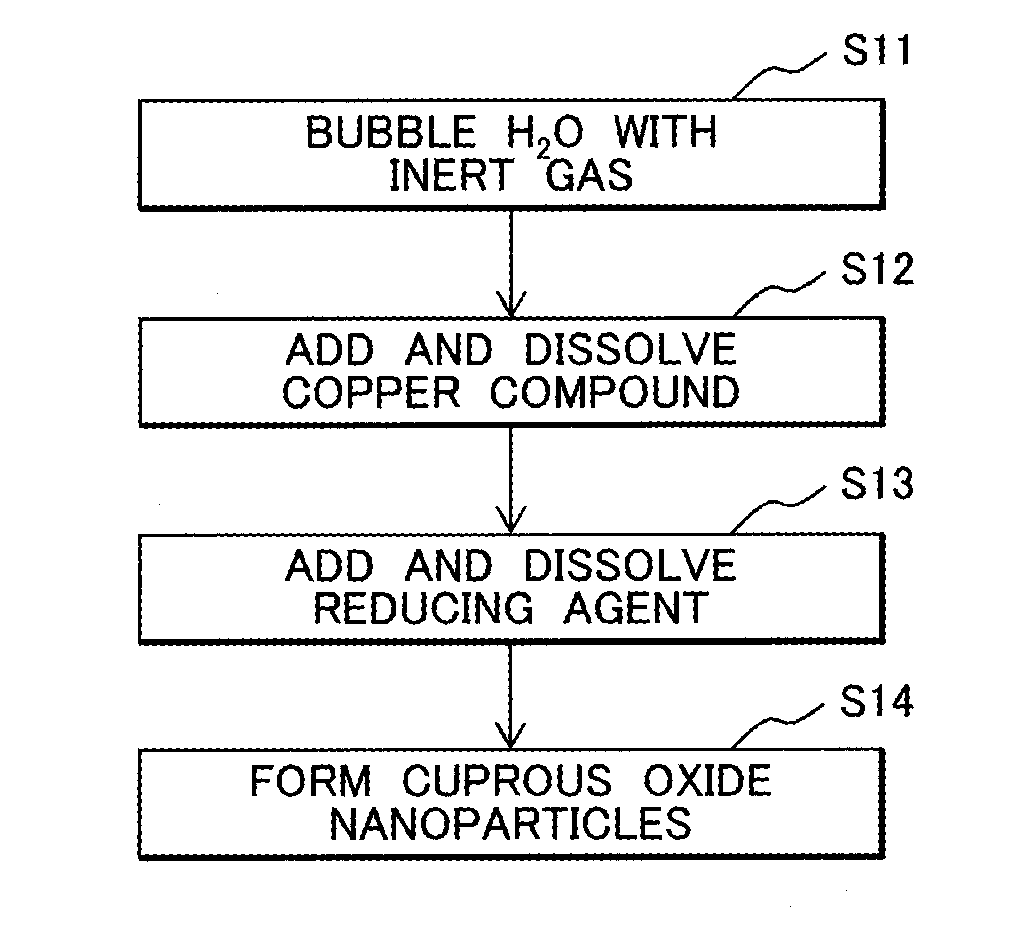Metal oxide particles for bonding, sintering binder including same, process for producing metal oxide particles for bonding, and method for bonding electronic components
a technology of metal oxide particles and metal oxide particles, which is applied in the direction of transportation and packaging, solid-state devices, non-conductive materials with dispersed conductive materials, etc., can solve the problems of metal copper oxidizing into cuprous oxide, silver tends to undergo ionic migration, and short circui
- Summary
- Abstract
- Description
- Claims
- Application Information
AI Technical Summary
Benefits of technology
Problems solved by technology
Method used
Image
Examples
example 1
[0065]Preparation of Copper Oxide Nanoparticles
[0066]There were used Cu(NO3)2.3H2O powder (supplied by Kanto Chemical Co., Inc.) as a material copper compound; water as a solvent; and NaBH4 (supplied by Kanto Chemical Co., Inc., 92.0%) as a precipitating agent for copper-cuprous oxide nanoparticles. Distilled water was bubbled with nitrogen for 30 minutes in a 1000-mL capacity beaker, and 1000 mL of the distilled water after bubbling were combined with the Cu(NO3)2.3H2O powder so as to give a copper ion concentration of 0.01 mol / L, and the powder was uniformly dissolved on a water bath at 40° C. Thereafter 0.2 to 0.6 mol / mL NaBH4 aqueous solution (50 mL) was added dropwise, and synthetically yielded copper-cuprous oxide nanoparticles.
[0067]After stirring at room temperature for 24 hours, the synthesized copper-cuprous oxide nanoparticles were subjected to centrifugal separation and cleaning (washing) each three times using a centrifugal cleaner Suprema 21 (supplied by Tomy Seiko Co....
example 2
[0077]Bonding Strength Test of Copper-Cuprous Oxide Composite Nanoparticles
[0078]Bonding strength tests were performed while simulating bonding of electronic components with each other. The tests were performed each in the following manner. Copper test specimens used in the measurement were a lower test specimen having a diameter of 10 mm and a thickness of 5 mm; and an upper test specimen having a diameter of 5 mm and a thickness of 2 mm. The prepared sintering binder was applied onto the lower test specimen, and the upper test specimen was placed on the applied sintering binder, followed by a sintering heat treatment at a temperature of 400° C. in hydrogen for 5 minutes. This process was performed while a load in terms of compacting pressure of 1.2 MPa was applied. A shear stress was loaded on the test specimens after bonding at a rate of shear of 30 mm / min, and a peak load at rupture was measured using a shear tester (Bond Tester SS-100KP, supplied by Seishin Trading Co., Ltd., m...
example 3
[0082]Application to Semiconductor Devices
[0083]FIG. 6A is a plan view of an insulated semiconductor device to which the present invention is applied. FIG. 6B is a cross-sectional view taken along the line A-A in FIG. 6A. FIG. 7 is a perspective view of the principal part of the device in FIG. 6A. FIG. 8 is a schematic enlarged cross-sectional view of a portion where the semiconductor element illustrated in FIG. 6A is placed. The semiconductor device will be illustrated below with reference to FIGS. 6A, 6B, 7, and 8.
[0084]A circuit board including a ceramic insulated substrate 303 and an interconnection layer 302 is bonded through a solder layer 309 to a supporting substrate 310. The interconnection layer 302 includes copper interconnections coated with nickel. A collector electrode 307 of the semiconductor element 301 is bonded to the interconnection layer 302 on the ceramic insulated substrate 303 through a bonding layer 305 formed from the copper-cuprous oxide composite particles...
PUM
| Property | Measurement | Unit |
|---|---|---|
| particle size | aaaaa | aaaaa |
| size | aaaaa | aaaaa |
| size | aaaaa | aaaaa |
Abstract
Description
Claims
Application Information
 Login to View More
Login to View More - R&D
- Intellectual Property
- Life Sciences
- Materials
- Tech Scout
- Unparalleled Data Quality
- Higher Quality Content
- 60% Fewer Hallucinations
Browse by: Latest US Patents, China's latest patents, Technical Efficacy Thesaurus, Application Domain, Technology Topic, Popular Technical Reports.
© 2025 PatSnap. All rights reserved.Legal|Privacy policy|Modern Slavery Act Transparency Statement|Sitemap|About US| Contact US: help@patsnap.com



